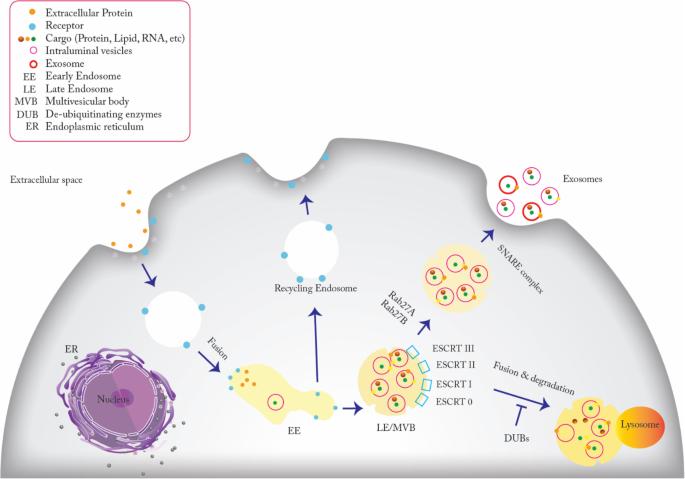Unraveling Biogenesis and Composition of Exosomes
Exosomes, a class of extracellular vesicles, have gained significant attention in the field of biology due to their diverse roles in intercellular communication and disease pathogenesis. These nanosized vesicles are released by various cell types and carry a cargo of nucleic acids, proteins, lipids, and other biomolecules. Understanding the biogenesis and composition of exosomes is crucial for unraveling their intricate functions and harnessing their potential as diagnostic and therapeutic tools.
Exosome Discovery and Composition
Exosomes were initially described in the 1980s, primarily as a way for cells to discard unnecessary proteins. They were thought to be a form of cellular waste disposal. However, further research has revealed that exosomes are involved in various physiological and pathological processes. The discovery of exosomes has opened up new avenues for understanding cell-to-cell communication and disease mechanisms.
Exosomes are enriched with a diverse array of biomolecules that reflect the physiological and pathological state of their parent cells. The composition of exosomes can vary depending on the cell type, cellular activation status, and environmental cues. Here, we explore the key components found within exosomes:
- Nucleic acids. Exosomes contain various types of nucleic acids, including messenger RNA (mRNA), microRNA (miRNA), long non-coding RNA (lncRNA), and DNA fragments. These nucleic acids can be transferred between cells through exosomes, influencing gene expression and cellular functions in recipient cells.
- Proteins. Exosomes carry a repertoire of proteins derived from the parent cells. These proteins include cytosolic proteins, membrane proteins, and proteins associated with exosome biogenesis, such as tetraspanins (CD9, CD63, CD81), heat shock proteins (HSP70, HSP90), and ESCRT-associated proteins. Specific protein markers can be used to identify and characterize exosomes, such as CD63 and CD81.
- Lipids. Exosomes are enriched with various lipid species, including cholesterol, sphingomyelin, phosphatidylserine, and phosphatidylcholine. Lipids play a crucial role in maintaining the structural integrity of exosomes and mediating interactions with recipient cells.
- Other biomolecules. Besides nucleic acids, proteins, and lipids, exosomes can also carry other biomolecules, such as metabolites, lipoproteins, and signaling molecules. These molecules contribute to the diverse functions of exosomes in intercellular communication and disease modulation.
Exosome Biogenesis
Exosome biogenesis is a complex and highly regulated process that involves the formation and release of intraluminal vesicles (ILVs) within multivesicular bodies (MVBs). This process can be divided into three main steps: endosomal maturation, ILV formation, and exosome release.
 Fig. 1 Exosome biogenesis and secretion within the endosomal system. (Mashouri L, et al., 2019)
Fig. 1 Exosome biogenesis and secretion within the endosomal system. (Mashouri L, et al., 2019)
- Endosomal maturation. The biogenesis of exosomes begins with the invagination of the plasma membrane, resulting in the formation of early endosomes. These early endosomes mature into late endosomes, also known as MVBs, through a series of molecular events mediated by endosomal sorting complexes required for transport (ESCRT) machinery.
- ILV formation. Within the MVBs, ILVs are generated through the inward budding of the endosomal membrane. This process involves the recruitment and assembly of ESCRT proteins, such as ESCRT-0, ESCRT-I, ESCRT-II, and ESCRT-III complexes, which orchestrate the budding and scission of ILVs. Additionally, ESCRT-independent mechanisms, including ceramide-mediated budding and tetraspanin-dependent microdomain formation, have also been implicated in ILV formation.
- Exosome release. Once ILVs are formed, MVBs have two possible fates. They can either fuse with lysosomes for degradation or undergo fusion with the plasma membrane, leading to the release of ILVs into the extracellular space as exosomes. The precise molecular machinery involved in exosome release is still under investigation, but it is known to involve Rab GTPases, SNARE proteins, and calcium-dependent fusion events.
Creative Bioarray Relevant Recommendations
Creative Bioarray provides the best quality lyophilized exosome standards obtained from several biological samples, including hundreds of different cell lines, plasma, serum, saliva, and urine as well as other bio-fluids. Our lyophilized exosome standards can be used as positive controls for multiple applications including Western blotting, ELISA, FACS, TEM, QRT-PCR, and many other quantitative calibration standards for exosomes in a variety of biological samples.
View the details of our exosome standards and find what you need!
Reference
- Mashouri L, et al. (2019). "Exosomes: composition, biogenesis, and mechanisms in cancer metastasis and drug resistance." Mol Cancer. 18 (1), 75.